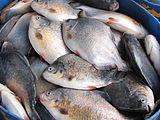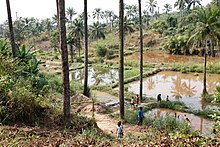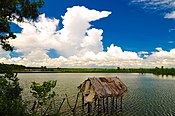
Fish farming or pisciculture is the principal form of aquaculture, while other methods may fall under mariculture. Fish farming involves raising fish commercially in tanks or enclosures, usually for food. A facility that releases juvenile fish into the wild for recreational fishing or to supplement a species' natural numbers is generally referred to as a fish hatchery. Worldwide, the most important fish species used in fish farming are carp, salmon, tilapia and catfish.

Major Species according to FAO
| Top ten freshwater, brackish water and marine cultured fish in 2010 | |||||
|---|---|---|---|---|---|
| Freshwater culture | Tonnage | Mariculture | Tonnage | Brackishwater culture | Tonnage |
| Grass carp | 4,337,114 | Atlantic salmon | 1,421,647 | Greasy grouper | 3,677,691 |
| Silver carp | 4,116,835 | Large yellow croaker | 378,622 | Flathead grey mullet | 333,322 |
| Catla (Indian carp) | 3,869,984 | Salmonids nei | 270,436 | Marine fishes nei | 112,539 |
| Common carp | 3,444,203 | Greasy grouper | 215,028 | Nile tilapia | 107,489 |
| Bighead carp | 2,585,962 | Sea trout | 143,751 | Cyprinids nei | 100,000 |
| Crucian carp | 2,217,798 | Japanese amberjack | 139,077 | Barramundi | 49,234 |
| Nile tilapia | 1,990,275 | Gilthead seabream | 118,212 | Marble goby | 34,123 |
| Pangas catfishes nei | 1,305,277 | Japanese seabass | 107,903 | Tilapias nei | 23,562 |
| Roho labeo | 1,167,315 | European seabass | 102,538 | European seabass | 23,313 |
| Freshwater fishes nei | 1,080,241 | Silver seabream | 73,924 | Mozambique tilapia | 17,103 |
| This chart is collected from Wikipedia | |||||
Indoor fish farming
An alternative to outdoor open ocean cage aquaculture, is through the use of a recirculation aquaculture system (RAS). A RAS is a series of culture tanks and filters where water is continuously recycled and monitored to keep optimal conditions year round. To prevent the deterioration of water  quality, the water is treated mechanically through the removal of particulate matter and biologically through the conversion of harmful accumulated chemicals into nontoxic ones.
quality, the water is treated mechanically through the removal of particulate matter and biologically through the conversion of harmful accumulated chemicals into nontoxic ones.
 quality, the water is treated mechanically through the removal of particulate matter and biologically through the conversion of harmful accumulated chemicals into nontoxic ones.
quality, the water is treated mechanically through the removal of particulate matter and biologically through the conversion of harmful accumulated chemicals into nontoxic ones.
Other treatments such as UV sterilization, ozonation, and oxygen injection are also used to maintain optimal water quality. Through this system, many of the environmental drawbacks of aquaculture are minimized including escaped fish, water usage, and the introduction of pollutants. The practices also increased feed-use efficiency growth by providing optimum water quality (Timmons et al., 2002; Piedrahita, 2003).
One of the drawbacks to recirculation aquaculture systems is water exchange. However, the rate of water exchange can be reduced through aquaponics, such as the incorporation of hydroponically grown plants (Corpron and Armstrong, 1983) and denitrification (Klas et al., 2006). Both methods reduce the amount of nitrate in the water, and can potentially eliminate the need for water exchanges, closing the aquaculture system from the environment. The amount of interaction between the aquaculture system and the environment can be measured through the cumulative feed burden (CFB kg/M3), which measures the amount of feed that goes into the RAS relative to the amount of water and waste discharged.










Hi, I like your post really I have read first-time Thanks for sharing keep up the good work.
ReplyDeletekatla-fish